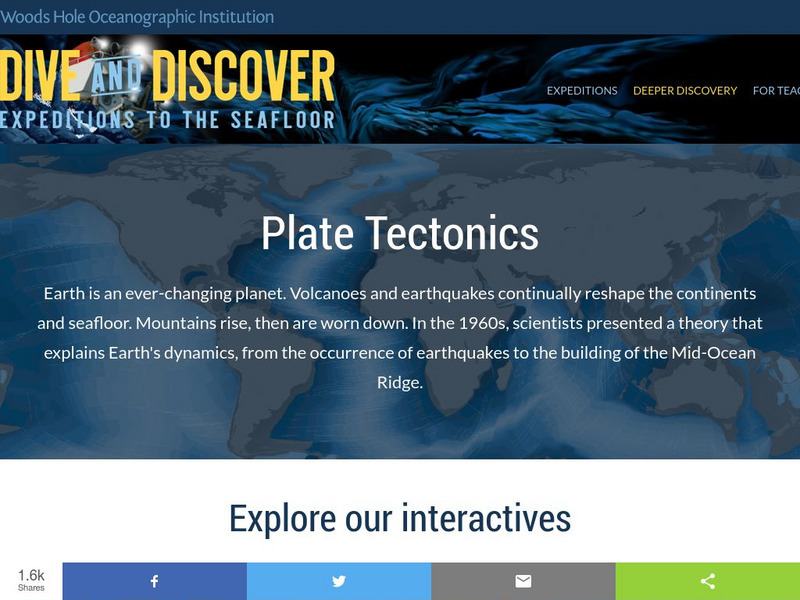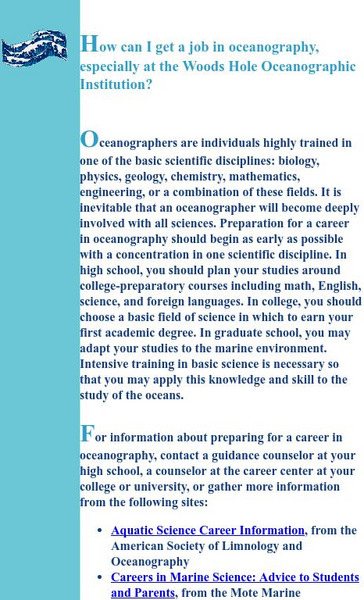Woods Hole Oceanographic Institution
Woods Hole Oceanography Institute: Hot Topics: Lava Flows
How long does it take a volcano to grow? What are the different types of lava? What's a lava tube? All of these questions are addressed by this resource.
Woods Hole Oceanographic Institution
Woods Hole Oceanography Institute: Hot Topics: Seafloor Magnetics
The earth's magnetic poles have reversed themselves throughout the earth's history. Find out how scientists know that this happened.
Woods Hole Oceanographic Institution
Woods Hole Oceanography Institute: Deep Sea Biology
What organisms can survive depths of 2,000 meters or more? Explore the strange creatures that occupy these depths. View a slideshow of deep-sea animals. This site also has a detailed diagram showing the biozones of the ocean.
Woods Hole Oceanographic Institution
Woods Hole Oceanography Institute: Introduction to the Galapagos Islands
Find out how scientists at Woods Hole Oceanography Institute use radiometric dating to figure out the age of volcanoes. A slideshow of the history of radiometric dating can also be viewed.
Woods Hole Oceanographic Institution
Woods Hole Oceanography Institute: History of the Earth
This interactive timeline reveals key geologic and biological events starting back 4.8 billion years to the present.
Woods Hole Oceanographic Institution
Woods Hole Oceanography Institute: History of Oceanography
An interactive timeline will guide you through the history of oceanography. The timeline stretches from 30,000 BCE to the present.
Woods Hole Oceanographic Institution
Woods Hole Oceanography Institute: The New England Seamounts
What is a seamount? Why are they found in long chains on the bottom of the ocean? Find answers to these questions as you explore a chain of seamounts located on the bottom of the Atlantic Ocean.
Woods Hole Oceanographic Institution
Woods Hole Oceanography Institute: Vent Basics
Use this interactive diagram to investigate the conditions which produce black smoker and white smoker hydrothermal vents.
Woods Hole Oceanographic Institution
Woods Hole Oceanography Institute: Vent Biology
Investigate nine different types of organisms that occupy deep-sea hydrothermal vents.
Woods Hole Oceanographic Institution
Woods Hole Oceanography Institute: Hydrothermal Vents
Explore actual photographs of the organisms and geologic structures of an oceanic hydrothermal vent. Additional links provide information about many of the physical properties of this extreme environment.
Woods Hole Oceanographic Institution
Woods Hole Oceanography Institute: Photosynthesis vs. Chemosynthesis
Compare and contrast the energy generating processes of chemosynthesis and photosynthesis with this interactive resource.
Woods Hole Oceanographic Institution
Woods Hole Oceanographic Institute: Undergraduate Resources: Marine Careers
What does an oceanographer do and study? This site looks at what marine scientists and students do and the research expeditions they take part in.
Woods Hole Oceanographic Institution
Expeditions to the Sea Floor: Plate Tectonics
Interactive site provides information on the Breakup of Pangea, plate boundaries, plate movements as well as a quiz.
Woods Hole Oceanographic Institution
Whoi: Oceanography Careers
Do you want to get started in preparing for a career in oceanography? Explore resources to start the career planning process.
Woods Hole Oceanographic Institution
Woods Hole Oceanography Institute: Bacteria at Hydrothermal Vents
Discover more about the thermophiles (bacteria) that live in hydrothermal vents ranging from the ocean floor to Yellowstone hotsprings.
Woods Hole Oceanographic Institution
Woods Hole Oceanography Institute: Comparing the Poles
Have you ever wondered how the Arctic differs from the Antarctic? This resources contrasts the physical features, organisms and human impact of these two regions.
Woods Hole Oceanographic Institution
Woods Hole Oceanographic Institute: What Are the Deepest Parts of the Ocean?
A brief description of the ocean's deepest parts.
Woods Hole Oceanographic Institution
Woods Hole Oceanography Institute: School Bus on a Pencil Line
The objective of this activity is to compare the depth of the ocean at the mid-ocean ridge to a familiar object.
Woods Hole Oceanographic Institution
Woods Hole Oceanography Institute: Current Patterns
This simple demonstration will help students understand how air currents and water currents can distribute substances through different environments.








